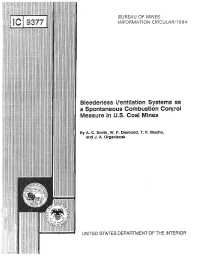Mining Publication: Bleederless Ventilation Systems as a Spontaneous Combustion Control Measure in U.S. Coal Mines
Original creation date: January 1994
The U.S. Bureau of Mines conducted a worldwide literature review of bleederless ventilation practices to evaluate their use as a spontaneous combustion control measure in U.S. coal mines. Factors that must be taken into account in the design and use of these systems include seal construction, the use of ventilation control devices, the use of methane-drainage systems in gassy mines, and the ground control plan. Monitoring for the detection of spontaneous combustion and the control of methane when methane-drainage techniques are employed is critical to the successful use of a bleederless ventilation system. This report describes the types of ventilation systems used throughout the world and the spontaneous combustion risks associated with these systems. Methane-drainage systems used in conjunction with bleederless ventilation systems are discussed. Ground control considerations such as pillar design, entry stability, and seal usage are reviewed. Monitoring systems for spontaneous combustion detection, methane-drainage control, and behind seals are examined. Finally, methods for evaluating the spontaneous combustion hazard of a mining operation to determine when the use of a bleederless ventilation system is warranted are reviewed.
Authors: AC Smith, WP Diamond, TP Mucho, JA Organiscak
Information Circular - January 1994
NIOSHTIC2 Number: 10004943
Pittsburgh, PA: U.S. Department of the Interior, Bureau of Mines, NTIS PB94-152816, IC 9377, 1994 Jan; :1-37
See Also
- Bleeder System in Virgin Area in a Pittsburgh Coalbed Mine
- CFD Modeling of Spontaneous Heating in a Large-Scale Coal Chamber
- CFD modelling of sampling locations for early detection of spontaneous combustion in long-wall gob areas
- Coal Mine Inertisation By Remote Application
- Effect of Longwall Face Advance on Spontaneous Heating in Longwall Gob Areas
- Reconciling Longwall Gob Gas Reservoirs and Venthole Production Performances Using Multiple Rate Drawdown Well Test Analysis
- SPONCOM - A Computer Program for the Prediction of the Spontaneous Combustion Potential of an Underground Coal Mine
- SponCom - Spontaneous Combustion Assessment Software - 2.0
- Technology News 545 - NIOSH Updates Spontaneous Combustion Assessment Software
- Three Coal Mine Ventilation Studies Using Sulfur Hexafluoride Tracer Gas
- Content source: National Institute for Occupational Safety and Health, Mining Program


 ShareCompartir
ShareCompartir
